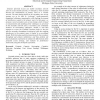Free Online Productivity Tools
i2Speak
i2Symbol
i2OCR
iTex2Img
iWeb2Print
iWeb2Shot
i2Type
iPdf2Split
iPdf2Merge
i2Bopomofo
i2Arabic
i2Style
i2Image
i2PDF
iLatex2Rtf
Sci2ools
GLOBECOM
2009
IEEE
2009
IEEE
Measurement Based Capacity Scavenging via Whitespace Modeling in Wireless Networks
Dynamic Spectrum Access can enable secondary network users to access unused spectrum, or whitespace, which is found between the transmissions of primary users in a wireless network. The main design objectives for secondary user access strategy are to be able to “scavenge” spatio-temporally fragmented whitespace opportunities while limiting the amount of interference caused to the primary users. In this paper, we propose a novel secondary user access strategy which is based on measurement and modeling of the whitespace as perceived by the secondary network users. A secondary user continually monitors its surrounding whitespace, models it, and then attempts to access the available spectrum holes so that the effective secondary throughput is maximized while the resulting interference to the primary users is limited to a pre-defined bound. We first develop analytical expressions for the secondary throughput and primary interference, and then perform ns2 based simulation experiments to...
| Added | 04 Sep 2010 |
| Updated | 04 Sep 2010 |
| Type | Conference |
| Year | 2009 |
| Where | GLOBECOM |
| Authors | Anthony Plummer Jr., Mahmoud Taghizadeh, Subir Biswas |
Comments (0)

